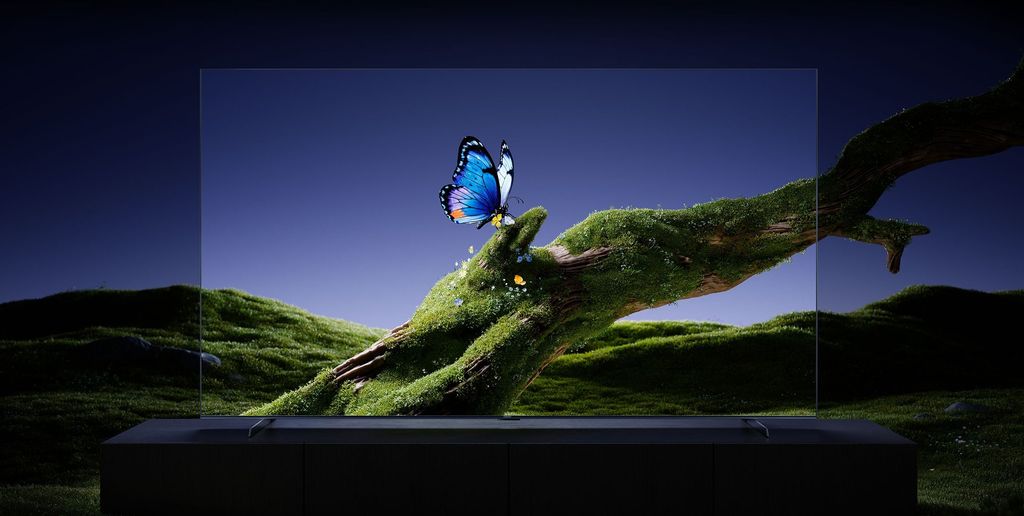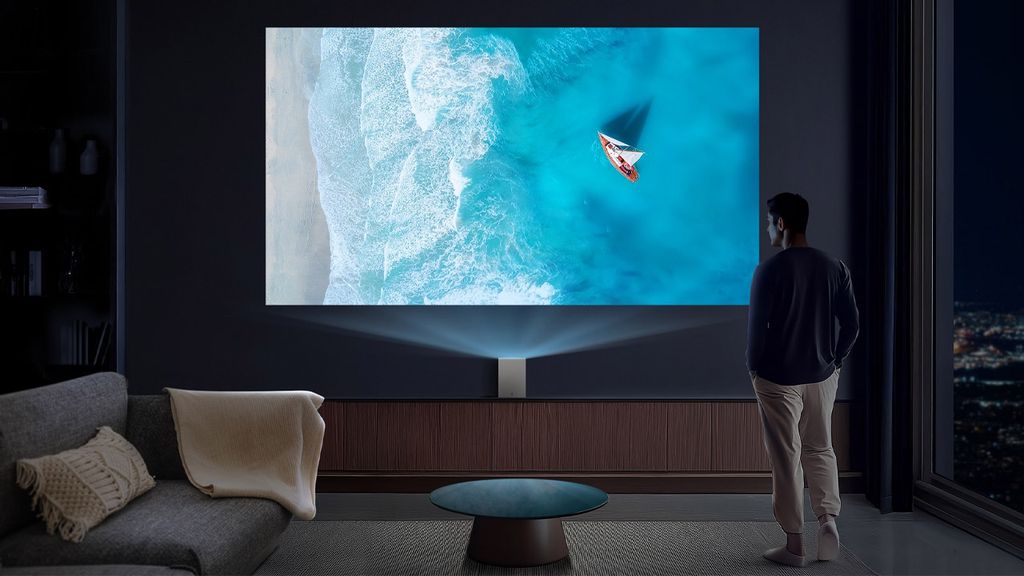- Matching (Score)
- Our verdict
- Competing TVs
- TV appearance
- Where to buy
- Contrast and black detail
- HDR effect quality
- Factory color reproduction
- Color reproduction after calibration
- Smoothness of tonal transitions
- Image scaling and smoothness of tonal transitions
- Blur and motion smoothness
- Console compatibility and gaming features
- Input lag
- Compatibility with PC
- Viewing angles
- Daytime performance
- TV features
- Apps
- Playing files from USB
- Sound
- Panel details
Xiaomi S Pro 2026 Review
Available screen sizes:

Complete the survey to find out the result
Refresh rate: 144Hz Brand: XIAOMI Resolution: 3840x2160 System: Google TV Model year: 2025
The premium television market has been dominated for years by the same, established players. However, alongside them, pretenders regularly emerge, trying to redefine the concept of "value for money." Xiaomi has long been part of the latter group, and their latest offering – the S Pro 2026 series – is meant to be the ultimate proof of this. On paper, the specifications are impressive: advanced Mini LED backlighting with thousands of dimming zones, a 144 Hz panel supporting the latest consoles, and a powerful processor for running Google TV. All of this is packaged at a price that is traditionally intended to embarrass the competition. The only question is whether it will succeed? We check this for you in this review!
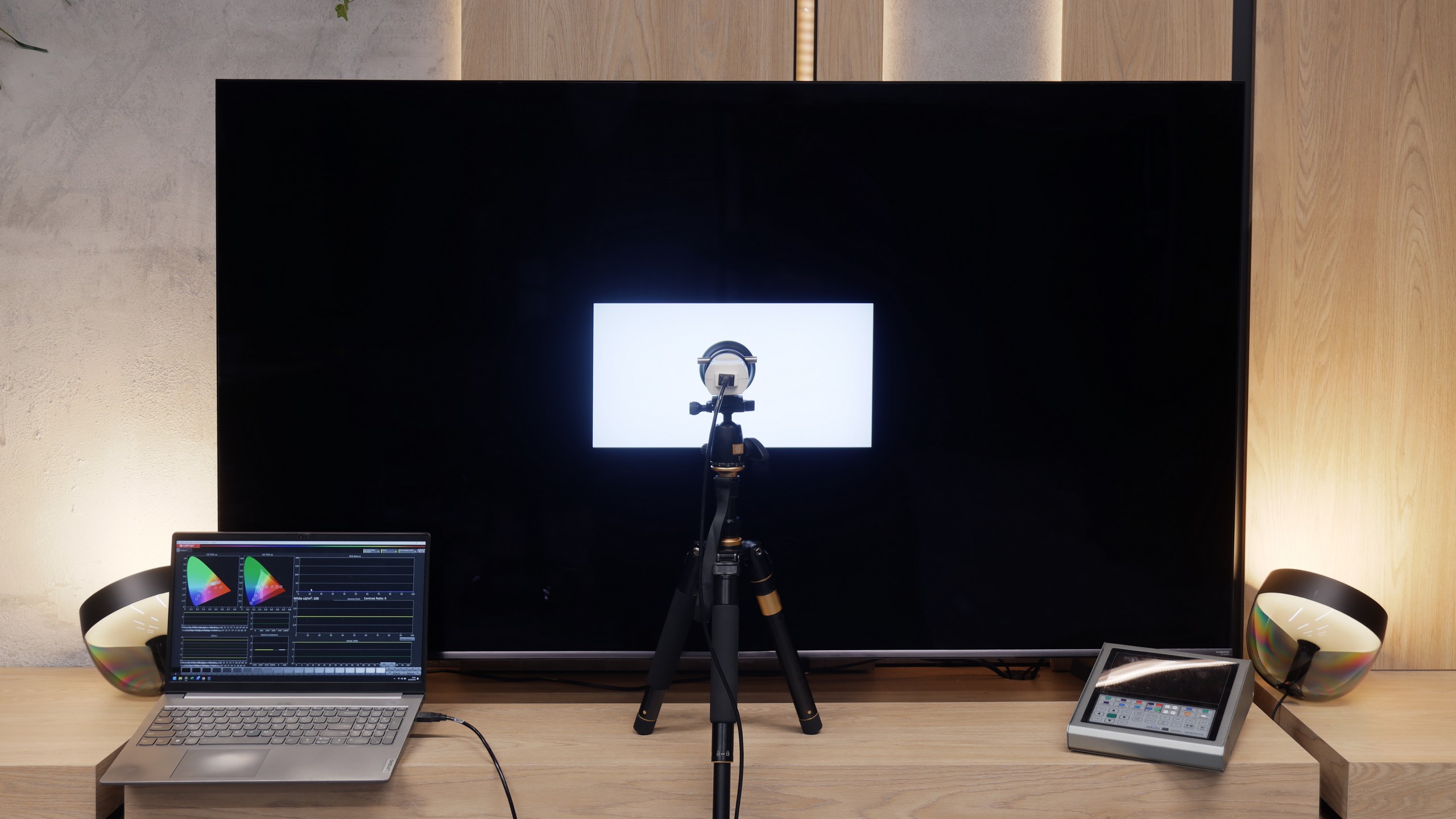
XIAOMI TV S PRO 2026 - Our verdict
7.2
Overall rating
Is it worth buying the Xiaomi S Pro 2026? The answer to this question is quite complicated. Let's start with what is really great about this television. First of all, the Xiaomi S Pro 2026 has an excellent price-to-specification ratio. We get a Mini LED panel with very high brightness that performs exceptionally well in a sunlit living room. Additionally, it has a fast refresh rate of 144 Hz (and even 288 Hz) and a full package for gamers: two HDMI 2.1 ports, support for VRR, and remarkably low input lag (below 10 ms). If we mainly watch "regular" content and play games, this is truly a fantastic screen. Even the built-in 30W speakers are surprisingly good and support Dolby Atmos. Unfortunately, there is also a second, very problematic side to this model. In short: the software. We have the impression that Xiaomi has provided us with excellent "parts," but could not make them work together correctly. The biggest issue is the HDR mode – the primary reason for buying a television today. For unknown reasons, the television in HDR mode (HDR10, Dolby Vision) does not manage its dimming zones well. As a result, the black that should be deep becomes gray or navy blue, like in a standard LCD television. There are also other software faults such as the terrible implementation of HGiG or the fact that the Dolby Vision mode for gamers is useless due to the enormous input lag (100 ms). Additionally, the television has very poor capabilities for digital image processing. So how can this be summarised in terms of price? In its price range, the Xiaomi S Pro 2026 crushes the competition in terms of specifications. Other televisions at this price point are usually basic LCD models without dimming and often only with a 60 Hz panel. The question is therefore: what is more important to you? If you are simply looking for a very bright and inexpensive television for watching TV during the day and gaming, and you are willing to calibrate it – you will be very satisfied with it. However, if you are looking for a television to enjoy stunning HDR in films and games right out of the box, you will be terribly disappointed with this model. In that case, in our opinion, it is better to pay a bit extra for a basic OLED television or a more refined Mini-LED model from the competition.
Advantages
Good black levels and contrast (SDR)
Very high peak brightness (great for a bright living room)
Complete package for gamers (144 Hz panel, HDMI 2.1, VRR)
Extremely low input lag in SDR mode (below 10 ms)
Surprisingly good, powerful sound (Branded by Harman Kardon)
Support for Dolby Atmos and DTS:X
Rich Google TV system (with AirPlay and Chromecast)
Proper compatibility with PC (clear fonts and 288Hz mode)
Outstanding value for the offered specification
Disadvantages
Local dimming algorithms practically do not work in HDR content
Useless Dolby Vision Gaming mode (input lag approx. 100 ms)
Poorly implemented HGiG mode
Highly visible banding (colour banding) in dark scenes
Very poor upscaling and digital image processing
Google TV system can "struggle"
Movies and series in UHD quality
6.7
Classic TV, YouTube
6.3
Sports broadcasts (TV and apps)
6.4
Gaming on console
7.7
TV as a computer monitor
8.6
Watching in bright light
7.4
Utility functions
7.2
Apps
9.6
Sound quality
7.1
Complete the survey to find out what fits your preferences
XIAOMI TV S PRO 2026 - Competing TVs in this price range
XIAOMI TV S PRO 2026 - TV appearance
HDMI inputs: 1 x HDMI 2.0, 2 x HDMI 2.1 (48Gbps) Outputs: Toslink (Optical audio), eARC (HDMI), ARC (HDMI), Mini-Jack (Headphones) Network Interfaces: Wi-Fi 2.4GHz, Wi-Fi 5GHz, Ethernet (LAN) 100Mbps
Build quality: Good
Stand type: Legs
Bezel color: Graphite





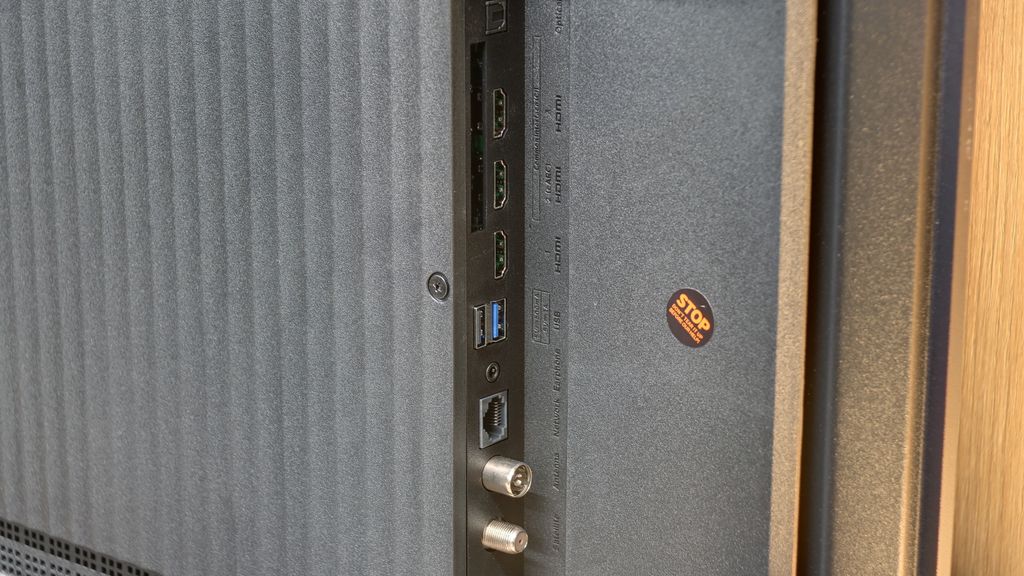


Stand: Fixed
Flat design: No
Accessories: Stand
It must be admitted that in terms of design, Xiaomi has undergone a kind of "glow-up" this year compared to last year's models. The television is really well-made, especially when we look at how often devices in the same price range appear. The S Pro 2026 stands on sturdy metal legs, which provide very good stability to the entire structure. The frame around the screen is quite slim, giving the device a modern look. The casing also features a few decorative touches. At the front, on the lower silver-grey frame, there is the Harman Kardon branding, suggesting that the speakers have been tuned in collaboration with this American company. Likewise, on the side of the device, we find a discreet Xiaomi logo along with the "Mini LED" logo. We must also commend the back of the device. The "back" of the television, although plastic and quite thick, has been very well designed. It has special embossments and channels for cables, allowing us to run them aesthetically and hide them so they do not protrude messily from the side. And although the S Pro 2026 may not be a premium-class device, it is clear that the designers' concept for this equipment was quite interesting and unique.
Buy at the best price
Select size:
XIAOMI TV S PRO 2026 - Contrast and black detail
7.4/10
Local dimming function: Yes, number of zones: 532 (28 x 19)

Result
1,001,650:1

Result
52,600:1

Result
17,900:1

Result
17,200:1

Result
10,150:1
Visibility of details in the lights:

Let's get to the point, which is what is most important in the Mini LED panel: black levels and contrast. The Xiaomi S Pro 2026 is built on a VA matrix, which already promises deep blacks from the start. Adding to that is the Mini LED backlighting with a very large number of local dimming zones. In the 65-inch variant we tested, we counted as many as 532. This is a solid number that should provide precise control over the backlighting. It should be noted that this number is proportional to the size – by choosing the smaller 55-inch variant, there will be correspondingly fewer zones, and in larger models, more.
So, how does the black level perform on the S Pro 2026? The answer is complex.
Overall, it is really quite good, and we see a clear improvement compared to the problematic model from 2025. As you can see from our measurement charts, the results are sometimes spectacular. In most of the film scenes we measured in SDR (standard dynamic range), the contrast could be confidently described as very good and even comparable to designs three times as expensive. Well, it could be... and here we come to the paradox of this model. The issue is how the television manages the zones in scenarios other than SDR. As soon as we feed the television a higher-quality signal, such as an HDR series or Dolby Vision from streaming platforms (Netflix, HBO Max or Disney+), something strange happens. We have the undeniable impression that the television suddenly... forgets that it has been equipped with local dimming zones at all. As can be seen in our video below, the black levels in such scenes resemble more shades of dark grey or navy blue. Additionally, there is a subtle flickering of the entire screen. This is a level we would expect from televisions entirely devoid of a local dimming system. It seems that Xiaomi decided to fix one, but key, flaw of last year's 2025 model over the course of a year. And they succeeded – we no longer have the annoying "zone disco", the image is stable. It's just a shame that when consuming content of the highest quality (HDR), this entire advanced system becomes completely useless.
Halo effect and black detail visibility:
XIAOMI TV S PRO 2026 - HDR effect quality
6.3/10
Supported formats: HDR10, HDR10+, Dolby Vision, HLG Color gamut coverage: DCI P3: 93.6%, Bt.2020: 70.9%
Luminance measurements in HDR:

Result
809 nit

Result
526 nit

Result
1033 nit

Result
469 nit

Result
718 nit
When it comes to HDR quality, the Xiaomi S Pro 2026 is undoubtedly a very bright television. On our synthetic measurement patterns, we were able to generate peak brightness of around 1400 nits. This result is not only very good but truly spectacular, considering the price of this model. However, as we always emphasise, for our editorial team, measurements and the experiences from the content viewed on a daily basis - from films and series - are more important. So let's analyse how the Xiaomi performs with film material. The result is, unfortunately, quite mixed. When very bright scenes appear on screen, the S Pro 2026 really shows its full potential and can achieve a real 800-1000 nits in bright elements. Moreover, even smaller objects can "burn" the eyes - in scenes from the film Sicario 2, small metal elements of the helicopter were truly vivid. The problem is that - and here the story comes full circle back to our contrast assessment - in such scenes we cannot count on absolutely cinematic black. In our opinion, this compromise is too great; high visibility of details in bright areas should not come at the cost of such a significant boost to black levels. And although the HDR effect itself can make a stunning impression here, it is essential to remember that when very challenging, mixed scenes appear on screen, we might feel a slight disappointment. Exactly the one we mentioned in the previous paragraph regarding issues with dimming in HDR mode. As a consolation, it is worth adding that the S Pro 2026 has been equipped with an additional PFS filter (similar in function to a QLED layer), which effectively broadens the colour gamut coverage. As a result, measurements showed DCI-P3 coverage reaching up to 94%. This gives us confidence that in most colourful scenes, the image will appear rich and appropriately saturated.
Scene from the movie “Pan” (about 2800 nits)

Scene from the movie “Billy Lynn” (about 1100 nits)

How does the S Pro 2026 handle image adaptation for HDR10 content, also known as "tone mapping"? We must admit that for the most popular content mastered to 1000 nits – which is what we most often encounter on streaming platforms – the Xiaomi S Pro 2026 looks really very good. When we played the test scene from the film Billy Lynn, it became clear that the television practically does not need to "adapt" to it. Its native brightness can easily generate such a high level, making the content simply look great without noticeable compromises. (Well, maybe apart from slightly slightly washed-out colours). The situation is a bit worse with the most demanding films, mastered to 4000 nits or more. Analyzing the reference scene from the film "Pan," we noticed that very bright elements, such as the sun's disc against a colourful sky, can appear slightly "blended" into one spot. It is clear that in such extreme conditions, the television's algorithms do not always perfectly map the brightest details, losing some information in the highlights. Nevertheless, it must be fairly concluded that in the most popular, everyday HDR productions, the Xiaomi S Pro 2026 definitely "holds its own" and may be appealing.
HDR luminance chart:
HDR luminance
Fortunately, in the case of the Xiaomi S Pro 2026, we do not have to worry too much about its self-mapping of tones in the HDR10 standard. This is because the television has been equipped with support for dynamic metadata in the form of Dolby Vision. This is crucial, as this format is found in practically every leading streaming platform. Thanks to dynamic metadata from Dolby, the Xiaomi S Pro 2026 can hold its own even in very extremely bright scenes. The Dolby Vision algorithm "guides" the television step by step, ensuring that we do not have to fear that most details in the highlights will simply escape us. Of course, one must remember that even here the implementation of Dolby Vision does not look as spectacular as on the best flagship screens on the market. Nevertheless, we have no doubt that in its price class it truly "delivers" and is a huge added value of this model.
Static HDR10

Dynamic: Dolby Vision

Factory color reproduction
4.1/10
Of course, all our measurements were carried out in "Film" mode, which is typically the best and most accurate choice we get straight out of the box. It needs to be said plainly: although it is the best mode, it is still very far from ideal. Firstly, the television has a clear tendency to impart a cool, bluish tint to the image – this is due to a poorly set white balance. Additionally, there is the issue of how the S Pro 2026 manages its brightness straight out of the box, which results in an overly vivid image. These two flaws contribute to truly significant colourimetric errors (Delta E). In HDR content, they were able to exceed our anticipated error scale of "10" by twofold (meaning values close to 20). As a reminder – the threshold for perceivable error by the human eye is a Delta E value of around 3. Results at the level of 20 indicate that the image significantly deviates from what the director intended.
Color reproduction after calibration
7.2/10
So how does the S Pro 2026 perform after our calibration procedure? We have to admit that after calibration, the television becomes a really very pleasant device for watching everyday content. As you can see in the graphs, in HD (SDR) materials, both white balance and gamma values have been brought to nearly perfection. Most importantly, colourimetric errors have become practically unnoticeable to the human eye. In this scenario, the S Pro 2026 is simply an excellent television that, after professional calibration, can provide a lot of enjoyment from watching. However, it is worth clearly noting – our efforts have not helped much in 4K HDR mode. Despite the calibration, the television still interprets the image quite strongly "in its own way," which is clearly visible in the measurement of the EOTF curve (brightness tracking). It’s a bit of a shame, as it shows that the problem lies not in the panel itself, but in the software. Underdeveloped image management algorithms in HDR content can, unfortunately, rule out this television for many more discerning users.


XIAOMI TV S PRO 2026 - Smoothness of tonal transitions
6.9/10
Let us now turn to the analysis of tonal transitions, that is, the fluidity with which the television can render transitions between closely related shades. In the case of the Xiaomi S Pro 2026, the image that emerges from this is distinctly ambivalent. On the one hand, we have bright gradations. When scenes with a blue sky or other smooth transitions in the light areas of the image appear on the screen, the S Pro 2026 handles them exemplary. They look perfectly smooth, with no visible artefacts.
Unfortunately, the situation changes dramatically as soon as dark scenes take the stage on the screen. Frankly speaking – they look really poor. Instead of a smooth tonal transition in the darkness, the screen very clearly shows the joins of colours and unappealing "stepping" of the gradients. This is very noticeable in darker films or games and can effectively ruin the viewing experience.








Image scaling and smoothness of tonal transitions
4.5/10
Smooth transition function

Image without overscan on the SD signal

Let's start with the issue we raised in the previous paragraph: can the television actually fix the problem of dreadful tonal transitions in dark scenes? Theoretically, yes – in the menu, we find a feature with the promising name "Colour Contour Removal." Well, "theoretically." Unfortunately, in practice, this setting – regardless of which of the three power levels is chosen – yielded absolutely no real results. So we are dealing with a feature that, in practice, only exists in the menu. Moving on to the quality of upscaling (scaling the image from a lower resolution to 4K), unfortunately, we have more bad news for you. The S Pro 2026 performs very poorly at this task. Interestingly, the phenomenon of "overscan" (slight cropping of the image) is not a major issue here. The fact is that the television simply displays a very raw, unprocessed image. Its attempt to upscale the signal to a higher resolution looks simply lacklustre and lacks any form of "intelligent" improvement. There is no denying it – the entire digital image processing is the real Achilles' heel of this model.
XIAOMI TV S PRO 2026 - Blur and motion smoothness
7.5/10
Maximum refresh rate of the panel: 144Hz
Film motion smoothing option: Yes
Blur reduction option: Yes
BFI function 60Hz: No
BFI function 120Hz: No
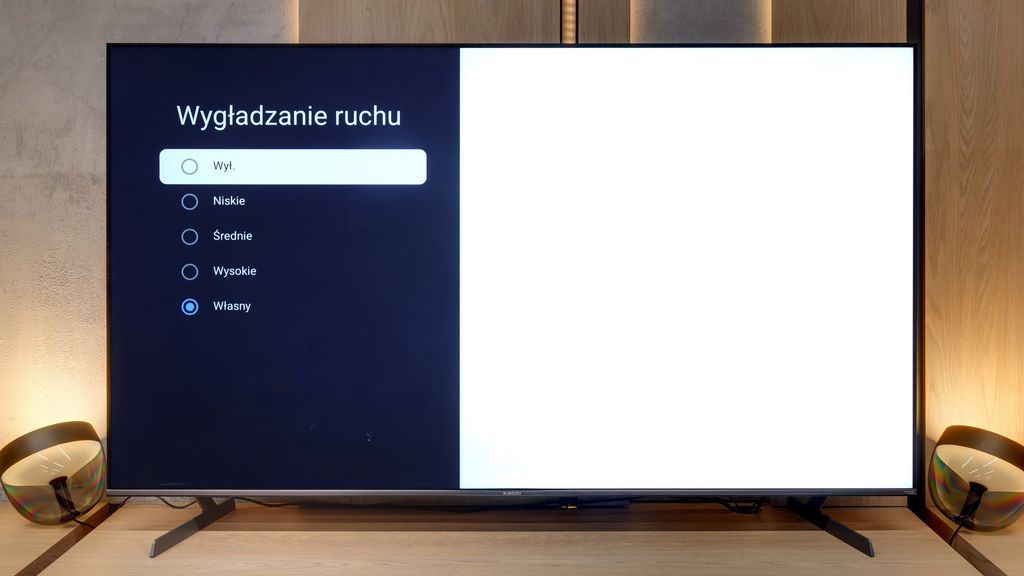
On paper, the S Pro 2026 specification looks impressive. The television is equipped with a native 144 Hz panel, with the ability to display images at up to 288 Hz in a dedicated gaming mode. These are amazing results, but what interested us most, in the context of everyday use, was how the television handles motion blur and how the image looks at 120 Hz. After all, this is the frequency used by consoles like the PlayStation 5 and Xbox Series X/S, and it is desired by sports fans. Generally, the panel "holds up". The matrix is sufficiently fast to meet these challenges, and objects displayed at native 120Hz fluidity are shown correctly. As for the software, the television is equipped with motion smoothing technology; however, with a key caveat – it works only for input signals up to 60 Hz. This means it is primarily suitable for traditional television, films, and series. Thanks to this, we can adjust the fluidity of the image to our own preferences – from a very smooth, "theatrical" approach to setting the slider to "zero" and maintaining a fully cinematic character.
Blur (native resolution, maximum refresh rate):



Blur (1080p@288Hz):



It is worth mentioning about the smearing that the S Pro 2026 is equipped with a VA panel. For this reason, it handles smearing moderately well. Although the panel has the capability to "refresh" the image at a speed of up to 288 Hz, it is important to remember that the physical capabilities of the pixels themselves (their response time) have their limitations. As a result, a trail behind a rapidly moving object may still be slightly visible.
XIAOMI TV S PRO 2026 - Console compatibility and gaming features
8.2/10
ALLM: Yes
VRR: Yes
VRR range: 48 - 144Hz
Dolby Vision Game Mode: Yes, high input lag
Correct implementation of HGIG: No
1080p@120Hz: Yes
1440p@120Hz: Yes
4K@120Hz: Yes
Game bar: Yes
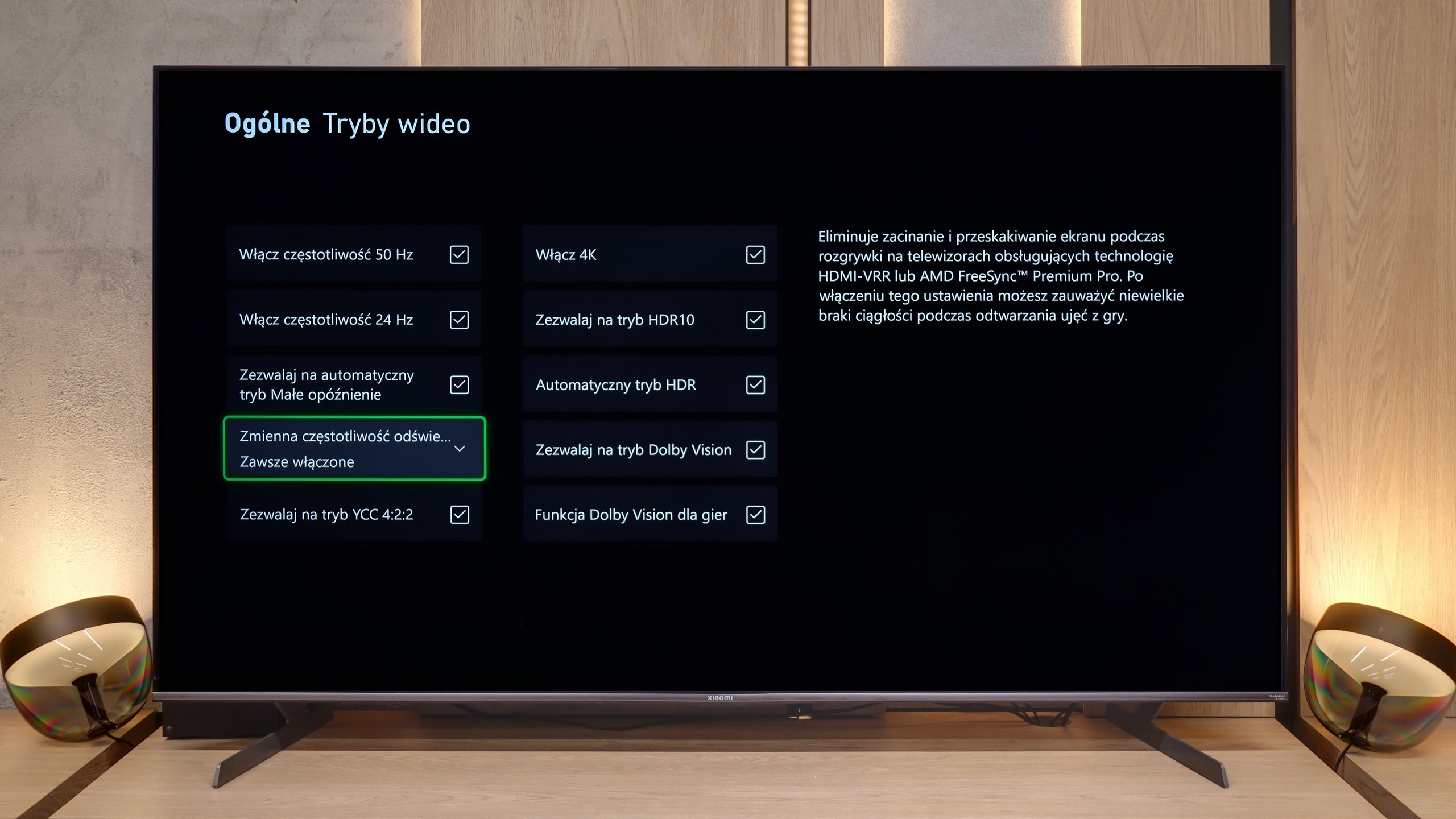
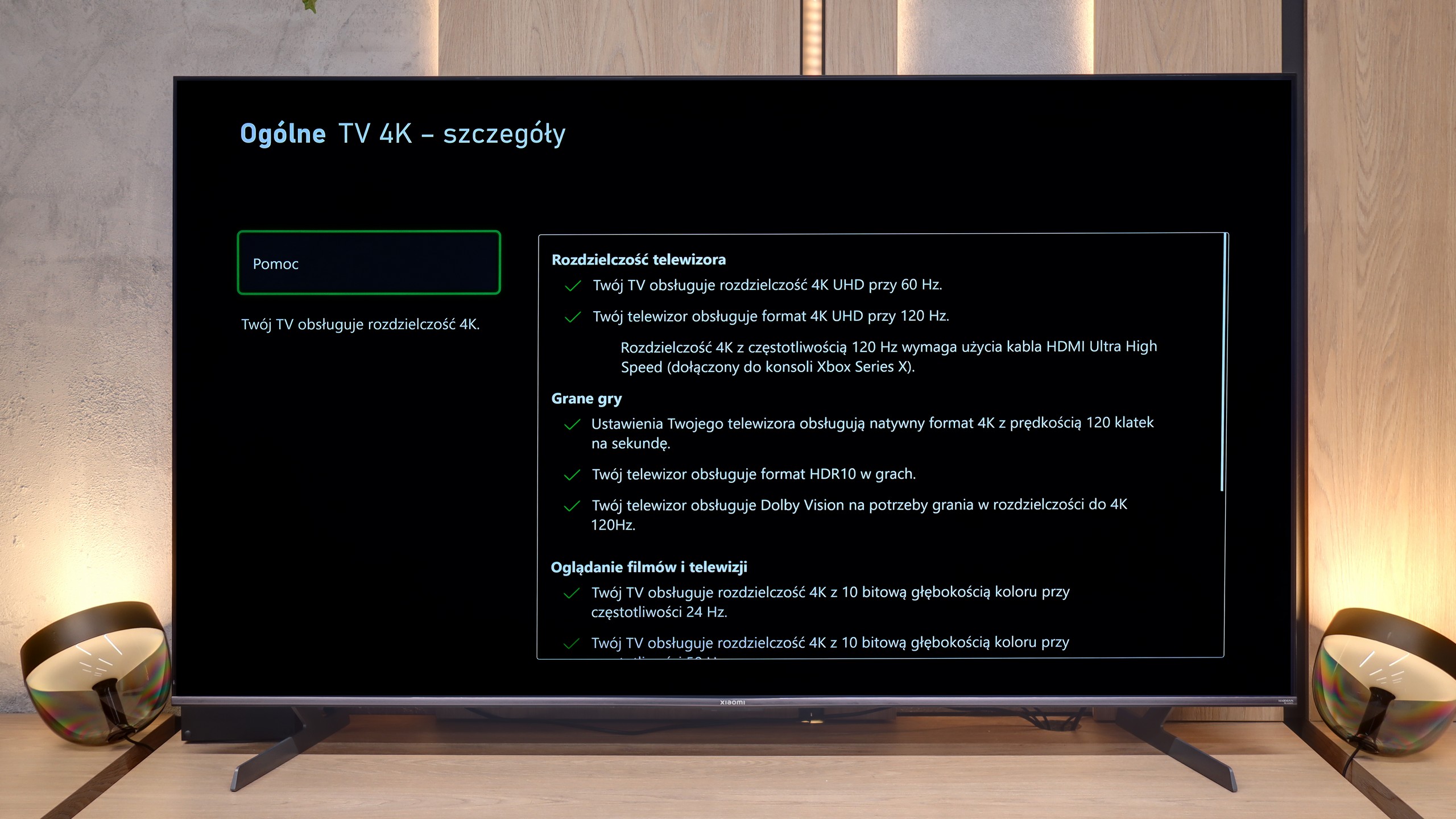
For gamers, the Xiaomi S Pro 2026 is almost an ideal proposition on paper. It is equipped with two HDMI 2.1 ports, which allow us to unlock (although these options are somewhat hidden in the menu) the full package of features: ALLM, VRR and, crucially, the ability to work in 4K at 144 Hz. This last feature should particularly please the owners of powerful PCs. The television also has something resembling a gamer panel – and although it's hard to call it a fully-fledged "Gamebar", it serves its purpose by displaying key information. It’s just a shame that in its default form, it obscures a relatively large portion of the screen.
The biggest issue we have with this model, however, concerns how the S Pro 2026 handles games in HDR mode. To put it bluntly: it doesn’t handle it well at all. Due to the television having a poorly implemented HGiG feature (the HDR tone mapping standard for games), it is very easy to "overexpose" the image during initial HDR calibration on the console. If someone is unaware of this software flaw and follows the on-screen instructions, they will simply set the image incorrectly, resulting in burnt-out details in the bright areas. Another major problem is the Dolby Vision mode for games. While it does work, it generates such a high input lag that it becomes noticeable in dynamic titles. (You can check all our lag measurements in the paragraph below). In summary: Generally speaking, this is a really very good screen for gamers, but with one small caveat. We would rather avoid using HDR mode on it – unless we decide to manually set the brightness bar on the console "by eye", completely ignoring the instructions from the console’s pictogram.

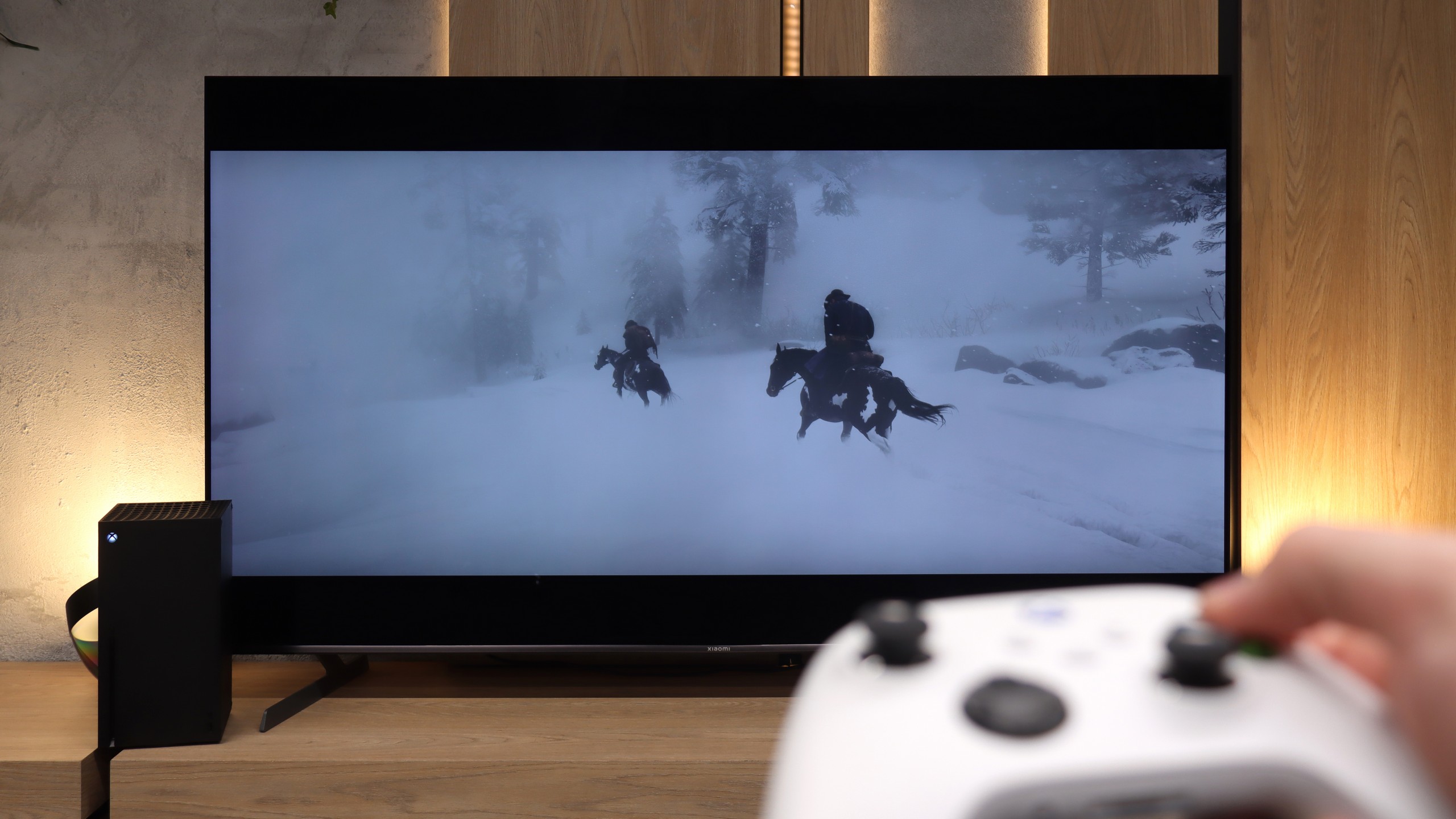

XIAOMI TV S PRO 2026 - Input lag
8.5/10
We move on to one of the most important measurements for gamers, namely signal delay (input lag). Overall, the Xiaomi S Pro 2026 performs excellently here. Generally, in game mode, the lag is very low. With 120 Hz content (from consoles or PCs), we easily achieved results below 10 ms. These are truly outstanding results and, in practice, completely imperceptible for most people, even those very sensitive to lag. Unfortunately, there is one "but" that constitutes the biggest flaw of this model in gaming. This is concerning the Dolby Vision Gaming mode. When this mode is activated, input lag rises to an astronomical level of around 100 ms. At this value, the delay between our movements on the controller (we tested on an Xbox console) and what is displayed on the screen becomes really significant and irritating. Therefore, our recommendation is simple: we absolutely do not recommend using the Dolby Vision Gaming mode on this television.
| SDR | HDR | Dolby Vision |
|---|---|---|
| 1080p60: 17 ms | 2160p60: 17 ms | 2160p60 DV: 110 ms |
| 1080p120: 8 ms | 2160p120: 8 ms | 2160p120 DV: 77 ms |
| 2160p60: 17 ms | ||
| 2160p120: 8 ms |

XIAOMI TV S PRO 2026 - Compatibility with PC
8.6/10
Chroma 444 (maximum resolution and refresh rate): Yes
Font clarity: Good
Readability of dark text and shapes: Good
Input lag in PC mode (4K, maximum refresh rate): 8ms
Matrix subpixel arrangement: BGR
Max refresh rate: 144Hz
G-Sync: Yes
Generally, when it comes to gaming, the S Pro 2026 is a fantastic screen for PC owners. It offers a refresh rate of up to 288 Hz at Full HD resolution or a full 144 Hz at 4K. All of this, supported by technologies such as AMD FreeSync or G-Sync, really caters to very demanding gamers. And what about "desktop" work? Here we have good news. Although the displayed font may not be perfectly sharp (like on a dedicated PC monitor with an IPS panel), it is presented in a really pleasant and readable manner. This is due to the proper implementation of Chroma 4:4:4 sampling, which ensures that text is clear and there are no issues with coloured fringes.
XIAOMI TV S PRO 2026 - Viewing angles
3.7/10
Brightness drop at an angle of 45 degrees: 66%
As for a television equipped with a VA panel, we must admit that the decrease in brightness when deviating from the screen's axis is relatively small in the Xiaomi S Pro 2026. However, one must remember the second, crucial aspect – colour saturation significantly degrades at angles. This is typical behaviour for televisions with VA panels that do not have additional coatings to widen viewing angles. Is this a downside of this television? Probably not. It's simply a characteristic, the price we have to pay for the key qualities of a VA panel in the form of its high native contrast.
XIAOMI TV S PRO 2026 - Daytime performance
7.4/10
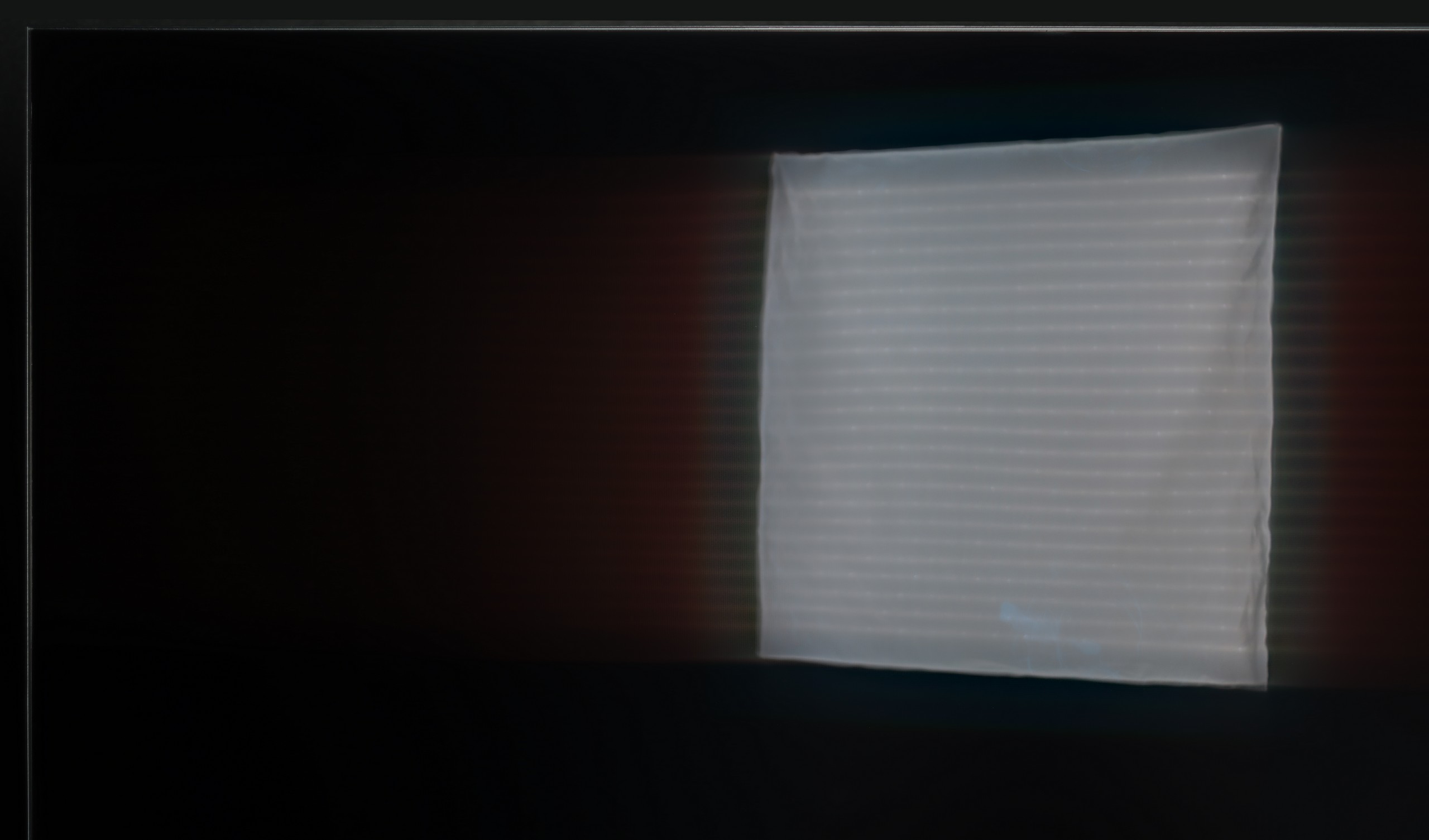

Panel finish: Glare
Reflection suppression: Average
Black levels during daytime: Very Good
Due to its very high peak brightness, the Xiaomi S Pro 2026 performs exceptionally well in brightly lit rooms. In most scenarios, it is capable of "cutting through" even very strong room lighting. However, it should be noted that the matrix used here averages out in terms of reflecting light. This means that in darker areas of the image, or when the television is displaying a dark scene, direct reflections (e.g. the reflection of a window or lamp) may be annoying. Nevertheless, the S Pro 2026, as a television for a bright living room, will perform very well indeed, thanks to its tremendous brightness.
Panel brightness
Average luminance SDR
Xiaomi S Pro 2026: 771 cd/m2
XIAOMI TV S PRO 2026 - TV features
7.2/10
System: Google TV
System performance: Decent
- HDMI inputs: 1 x HDMI 2.0, 2 x HDMI 2.1 48Gbps
- Outputs: Toslink (Optical audio), eARC (HDMI), ARC (HDMI), Mini-Jack (Headphones)
- Network Interfaces: Wi-Fi 2.4GHz, Wi-Fi 5GHz, Ethernet (LAN) 100Mbps
- TV reception: DVB-T, DVB-T2, DVB-S, DVB-S2, DVB-C
Classic features:
Recording to USB (terrestrial TV): No
Recording programming: No
Picture in Picture (PiP): No
RF remote control (no need to aim at the screen): RF
Backlit remote control: No
Teletext: Yes
Audio only mode: Yes
Bluetooth headphones support: Yes
Simultaneous Bluetooth headphones & TV audio: No
Smart features:
AirPlay: Yes
Screen mirroring (Windows Miracast): Yes
Voice search: Yes
Voice search in native language: Yes
Ability to connect a keyboard and mouse: Yes
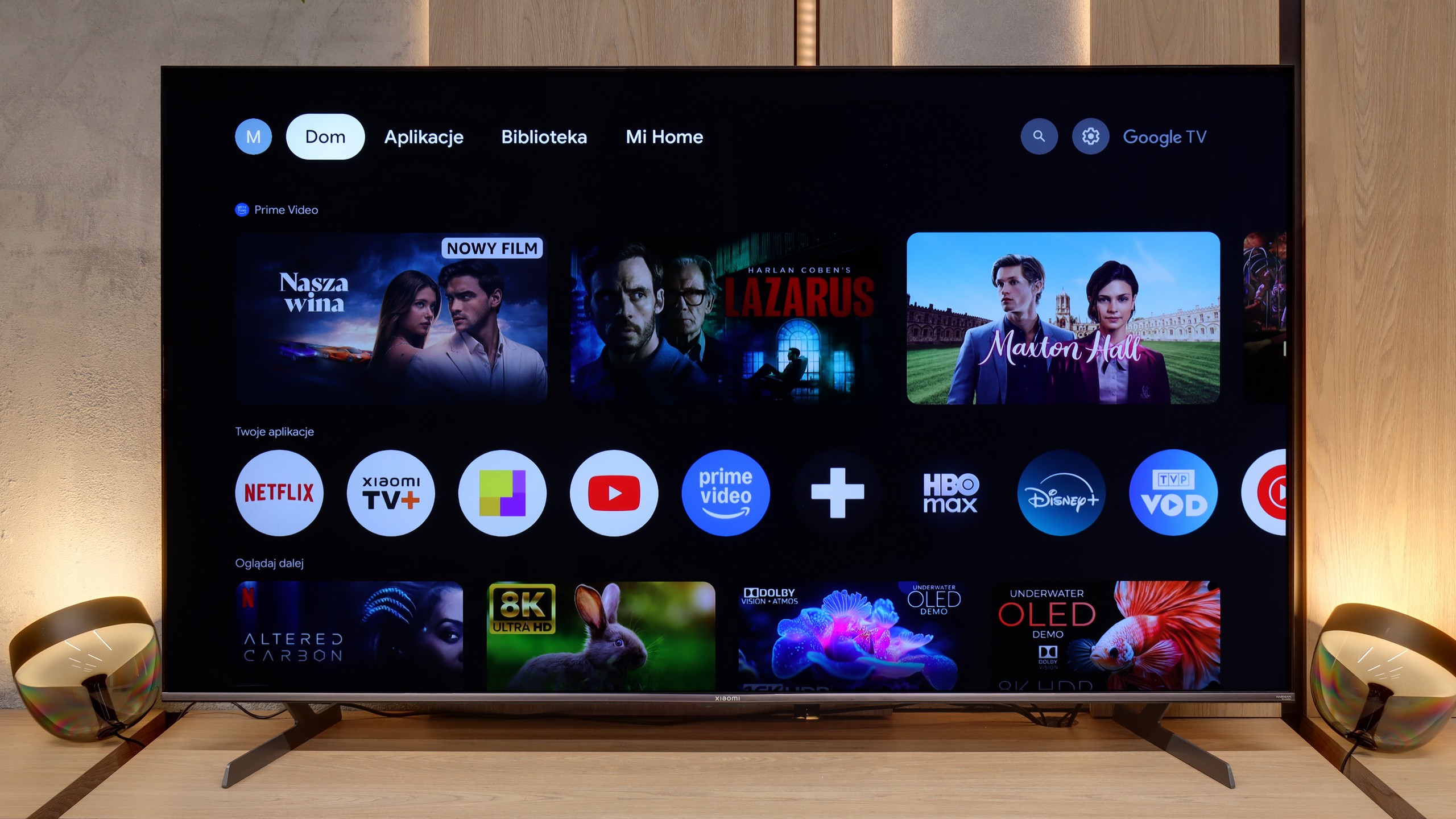





Operating System (Google TV)
The enormous advantage of the Xiaomi S Pro 2026 is undoubtedly the presence of the Google TV system. This gives us access to a gigantic library of applications – we can find literally everything here, from leading VOD platforms to niche players. The system also offers a plethora of useful features, such as a built-in Chromecast, support for AirPlay and Screen Mirroring, as well as an efficiently functioning voice search. The Google TV system itself is great, but one must take a slight grain of salt with its implementation by Xiaomi. During our tests, it occasionally exhibited what could be described as a "breathlessness." Animations could stutter slightly, and the response to commands was not immediate. This is certainly not the level of fluidity that we are accustomed to with top-tier, significantly more expensive models equipped with more powerful processors.
Television Features and Connectivity
How does the S Pro 2026 perform as a "regular" television? Unfortunately, here we have less good news. In terms of traditional television viewing, we can only commend this model mainly for having a convenient remote control with a numeric keypad – which (surprisingly) is not a standard today. However, this is where the conveniences end. We will not find either USB recording functionality (PVR) or a PiP (Picture-in-Picture) option. On the plus side, we appreciate the extensive Bluetooth connectivity options. We were able to connect external devices to the television, such as wireless headphones, a keyboard, or a mouse, without any issues, which significantly simplifies operation.
Sound connection options
HDMI audio:
Other audio outputs:
Toslink: Yes
Stereo (Mini-Jack): Yes
Wireless audio:
Bluetooth: Yes
Supported audio formats (external HDMI eARC audio):
Dolby Digital Plus 7.1: Yes
Dolby True HD 7.1: No
Dolby Atmos in Dolby Digital Plus (JOC): Yes
Dolby Atmos in Dolby True HD: No
DTS:X in DTS-HD MA: Yes
DTS-HD Master Audio: Yes
Senior accessibility
Numeric keyboard on TV: Yes
Font size adjustment: Yes
Audio description: Yes
XIAOMI TV S PRO 2026 - Apps
9.6/10























XIAOMI TV S PRO 2026 - Playing files from USB
6.8/10

| Maximum photo resolution: | Supported photo formats: |
|---|---|
The built-in, default media player in the Xiaomi S Pro 2026 is – given the capabilities of the Google TV system – simply weak. Its biggest drawback is the fact that it does not support characters other than those from the standard alphabet. As a result, it does not display, among others, Polish fonts in subtitles or file names. Fortunately, as we have already mentioned, the heart of the television is Google TV. This system allows for the quick installation of an external, significantly better player, such as VLC or Kodi. For this television, we recommend installing an alternative player immediately after the first start-up.
XIAOMI TV S PRO 2026 - Sound
7.1/10
82dB
Maximum volume
Supported codecs
(TV speakers)
Dolby Digital Plus 7.1
Dolby True HD 7.1
Dolby Atmos in Dolby Digital Plus (JOC)
Dolby Atmos in Dolby True HD
DTS:X in DTS-HD MA
DTS-HD Master Audio
We have to admit that the S Pro 2026 has pleasantly surprised us. The television is equipped with a 30W speaker system, which, for its class, sounds really very good. There is even a noticeable hint of bass, and the mid and high tones are quite well balanced. Of course, all of this is within the capabilities of what the television's speakers can deliver, yet it is a level we did not expect from such a relatively inexpensive model. A huge plus is also the support for top audio technologies. The television is capable of decoding not only the very popular Dolby Atmos format but also the recently quite rarely seen DTS:X, which we mainly find on Blu-ray discs.
Sound Quality Test:
Acoustic Measurements
82dBC (Max)
75dBC
XIAOMI TV S PRO 2026 - Panel details
Software version during testing: UKN1.240806.107.V816.0.25.6.6.ULBMIXM
Image processor: mt5896 2,5gb ram
Subpixel Structure:
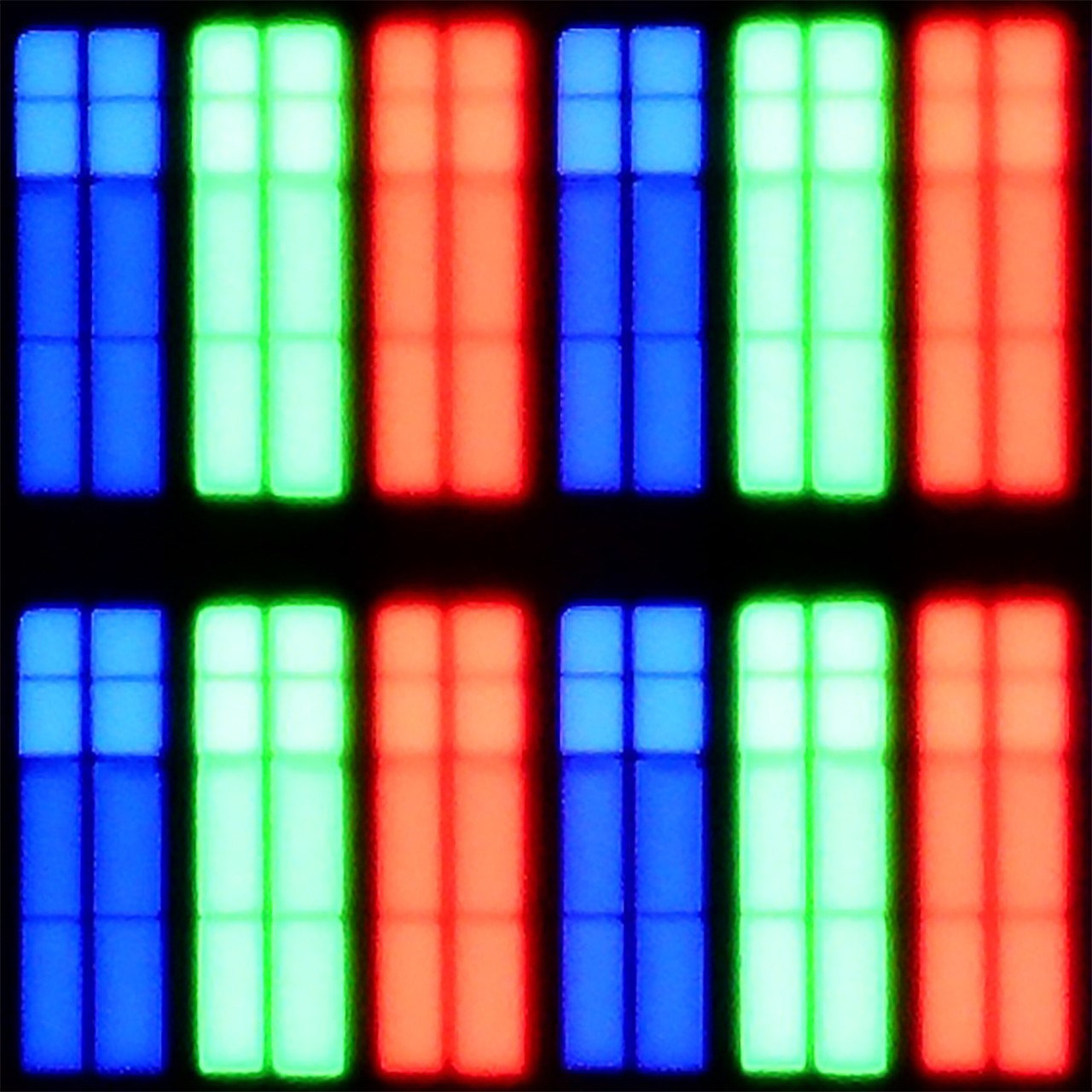
Panel uniformity and thermal imaging:
Backlight Type: Mini-LED PFS LED

Founder and originator of the "ChooseTV" portal

Journalist, reviewer, and columnist for the "ChooseTV" portal
See articles related to Xiaomi S Pro 2026:
10/27/2025
4/3/2025




